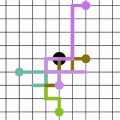Inspired by random walk on graphs, diffusion map (DM) is a class of unsupervised machine learning that offers automatic identification of low-dimensional data structure hidden in a high-dimensional dataset. In recent years, among its many applications, DM has been successfully applied to discover relevant order parameters in many-body systems, enabling automatic classification of quantum phases of matter. However, classical DM algorithm is computationally prohibitive for a large dataset, and any reduction of the time complexity would be desirable. With a quantum computational speedup in mind, we propose a quantum algorithm for DM, termed quantum diffusion map (qDM). Our qDM takes as an input N classical data vectors, performs an eigen-decomposition of the Markov transition matrix in time $O(\log^3 N)$, and classically constructs the diffusion map via the readout (tomography) of the eigenvectors, giving a total runtime of $O(N^2 \text{polylog}\, N)$. Lastly, quantum subroutines in qDM for constructing a Markov transition operator, and for analyzing its spectral properties can also be useful for other random walk-based algorithms.
翻译:散射图(DM)是一组不受监督的机器学习,可以自动识别隐藏在高维数据集中的低维数据结构。近年来,DM在许多应用中成功地应用于发现许多机体系统中的相关定序参数,从而能够对物质量子阶段进行自动分类。然而,传统的DM算法对于大型数据集来说在计算上令人望而却望而却步,时间复杂性的任何降低都是可取的。在考虑量子计算速度的情况下,我们为DM提出一个量子算法,称为量子扩散图(qDM)。我们的qDM作为一种输入的N 古典数据矢量器,在时间上对Markov过渡矩阵进行egen-decomposition,用$O(\log%3 N) 来进行一个egen-decommission,并典型地通过读出(tography)来构造扩散图,给一个总运行时间为$O(N%2)\ text{polylog ⁇,N$。最后,qDM可以将量子次routine 用于建造Markov过渡操作并分析其他光谱特性。




